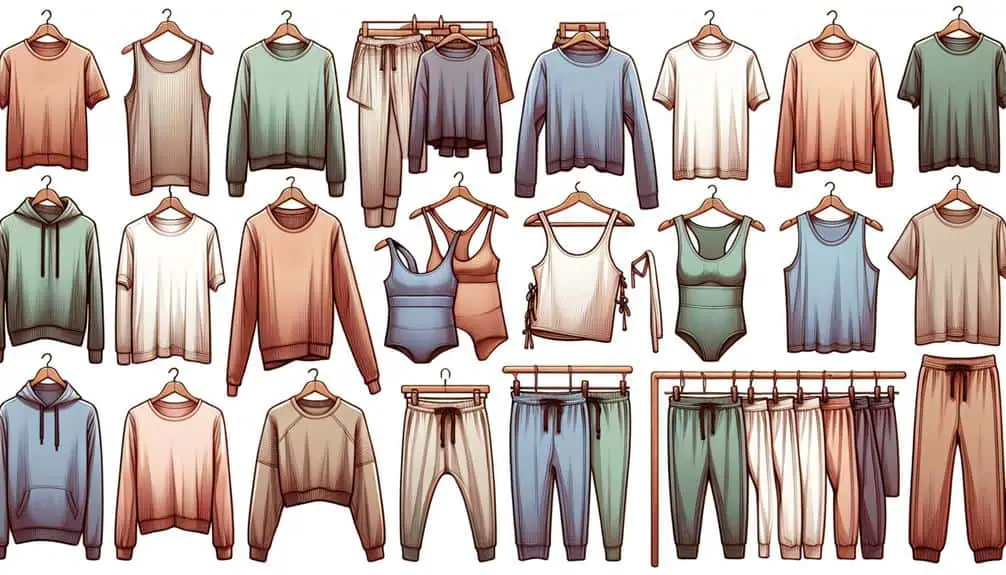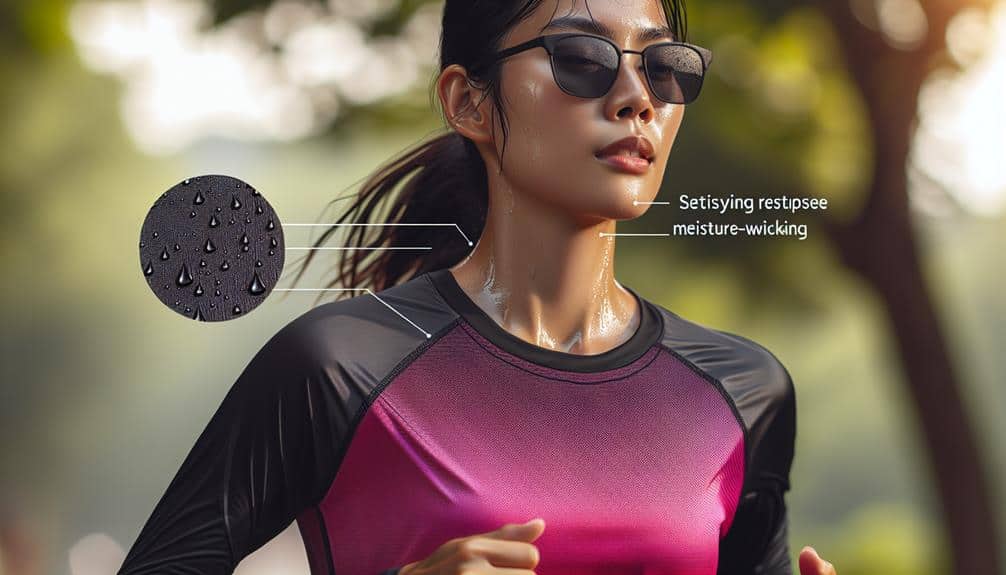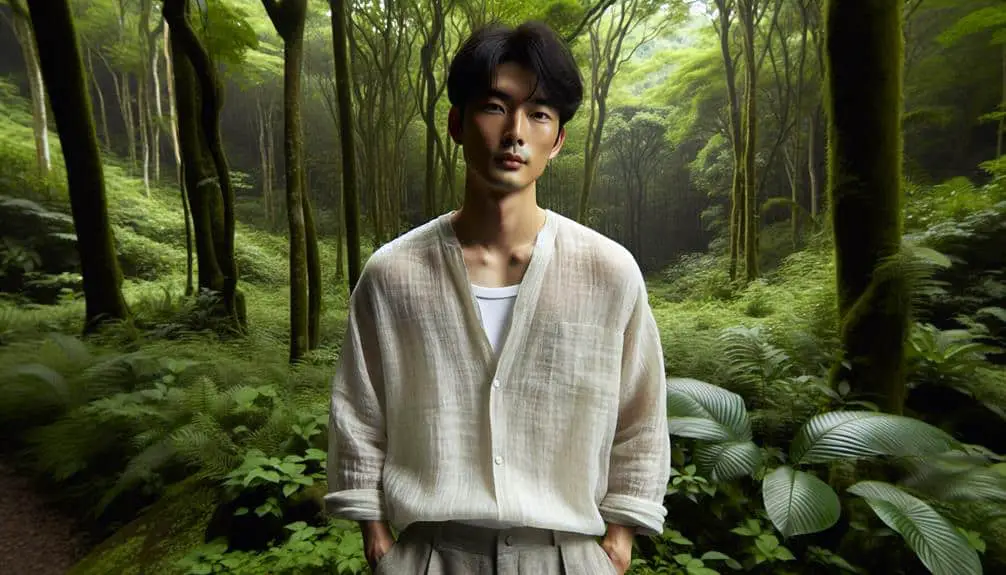When choosing eco-friendly moisture-wicking clothing, opt for bamboo fabric, organic cotton, recycled polyester, hemp, and linen. Bamboo is soft, sustainable, and breathable. Organic cotton promotes ethical farming and biodegradability. Recycled polyester reduces plastic waste and supports eco-friendly production. Hemp offers strength, durability, and UV resistance. Linen provides superior moisture-wicking and breathability. Each material contributes to sustainable practices in the fashion industry, aligning with your goal of eco-conscious choices. Learn more about these top choices for moisture-wicking clothing and their environmental benefits.
Key Points
- Bamboo fabric: sustainable, soft, and moisture-wicking.
- Organic cotton: breathable, biodegradable, and supports ethical farming.
- Recycled polyester: eco-friendly, reduces plastic waste, and high performance.
- Hemp athletic wear: durable, UV resistant, and minimal water usage.
- Linen garments: biodegradable, moisture-wicking, and superior breathability.
Benefits of Bamboo Fabric
When considering eco-friendly moisture-wicking clothing, bamboo fabric stands out for its numerous benefits. Bamboo fabric boasts sustainable properties, making it an eco-conscious choice for individuals seeking environmentally friendly apparel. The fabric is derived from bamboo grass, known for its rapid growth without the need for pesticides or chemicals, aligning well with sustainability goals.
Not only is bamboo fabric environmentally friendly, but it also offers a comfortable fit. The material is soft to the touch, making it gentle on the skin and ideal for those with sensitive skin. Additionally, bamboo fabric is breathable, allowing for excellent airflow and moisture-wicking properties. This feature is particularly beneficial for activewear, as it helps keep the body dry and cool during physical activities.
Organic Cotton Performance Apparel
Organic cotton performance apparel offers a sustainable and functional alternative for individuals seeking eco-friendly activewear options. Sustainable textiles like organic cotton are grown without the use of synthetic pesticides and fertilizers, reducing environmental impact. Organic cotton is biodegradable, further contributing to its eco-friendly nature.
In eco-friendly fashion, the use of organic cotton in performance apparel provides breathability and moisture-wicking properties similar to conventional cotton. This makes it a suitable choice for activewear that keeps you comfortable during workouts while being gentle on the environment.
Choosing organic cotton performance apparel supports sustainable practices in the fashion industry. By opting for garments made from organic cotton, you're promoting better soil health, reducing water consumption, and supporting ethical farming practices. These benefits align with the values of individuals seeking eco-friendly and sustainable activewear options.
Recycled Polyester Activewear
Recycled polyester activewear offers a sustainable solution for environmentally conscious consumers looking for durable and performance-driven clothing options. This type of activewear is created through the process of repurposing existing polyester materials, such as plastic bottles, into new fabric for athletic apparel. The sustainable design of recycled polyester activewear helps reduce the amount of plastic waste in landfills and minimizes the need for virgin polyester production, which can have a significant environmental impact.
In addition to promoting sustainable practices, recycled polyester activewear is known for its eco-friendly production methods. Manufacturers utilize energy-efficient processes and reduce water usage during production, further lessening the environmental footprint of the clothing. Despite being made from recycled materials, this activewear maintains high-quality performance features, including moisture-wicking capabilities and durability, making it a popular choice among athletes and individuals leading an active lifestyle.
When selecting activewear, opting for recycled polyester garments not only supports sustainable fashion choices but also contributes to the conservation of resources and reduction of waste in the fashion industry.
Hemp Athletic Wear
Manufacturers have increasingly embraced the use of hemp fibers in creating athletic wear due to their sustainable properties and durability. Sustainable hemp is known for being one of the most environmentally friendly fabrics available, requiring minimal water, pesticides, and synthetic fertilizers during cultivation. Hemp athletic wear isn't only eco-conscious but also highly functional.
The fabric is naturally breathable, making it an ideal choice for activewear that wicks moisture away from the body, keeping you dry and comfortable during intense workouts.
Hemp fibers are also incredibly strong and durable, ensuring that your athletic wear lasts through many wears and washes. Additionally, hemp is naturally resistant to mold and UV light, making it a great option for outdoor activities.
When looking for breathable activewear that's both sustainable and long-lasting, hemp athletic wear is a top choice. Its moisture-wicking properties, combined with its eco-friendly nature, make it a favorite among those who prioritize performance and sustainability in their athletic clothing choices.
Linen Moisture-Wicking Garments
As the demand for sustainable activewear continues to grow, linen moisture-wicking garments are emerging as a favorable choice for eco-conscious consumers seeking breathable and durable athletic clothing options. Linen, derived from the flax plant, is renowned for its eco-friendly properties. The fabric is biodegradable, requiring minimal water and pesticides during cultivation, making it a top contender in the domain of sustainable activewear.
Linen moisture-wicking garments offer a natural alternative to synthetic materials, ensuring comfort and performance during workouts. Its moisture-wicking ability surpasses many synthetic fabrics, keeping you dry and cool even during intense physical activities. Additionally, linen is highly breathable, allowing for excellent airflow, which is essential for regulating body temperature during exercise.
When considering eco-friendly sportswear options, linen garments stand out for their durability and longevity. With proper care, linen clothing can last for years, reducing the need for frequent replacements and minimizing environmental impact. Embrace the benefits of linen moisture-wicking garments for a sustainable and stylish addition to your athletic wardrobe.
Frequently Asked Questions
Are There Any Specific Care Instructions for Maintaining the Moisture-Wicking Properties of These Eco-Friendly Clothing Choices?
To maintain moisture-wicking properties of eco-friendly clothing, wash in cold water, avoid fabric softeners, and air dry when possible. This helps maintain durability and long-term effectiveness. Using these care instructions can minimize environmental impact.
How Does the Production Process of These Sustainable Fabrics Compare to Traditional Synthetic Materials in Terms of Environmental Impact?
When comparing sustainable fabric production to traditional synthetics, the environmental impact is significant. Sustainability practices in the production process of eco-friendly materials reduce harm to the environment, making them a more eco-conscious choice.
Can These Moisture-Wicking Clothing Options Be Easily Recycled or Repurposed at the End of Their Lifecycle?
Recycling options for moisture-wicking clothing vary based on material composition. Polyester blends can be broken down and repurposed into new textiles, reducing waste. Repurposing ideas include turning old garments into cleaning rags or DIY projects, promoting sustainability.
Are There Any Certifications or Standards That Consumers Should Look for When Shopping for Eco-Friendly Moisture-Wicking Apparel?
When shopping for eco-friendly moisture-wicking apparel, look for certifications like OEKO-TEX or bluesign. These standards guarantee sustainability, performance, and durability. Check care instructions for washing tips to uphold the garment's eco-friendly qualities longer.
How Do These Eco-Friendly Fabrics Perform in Extreme Weather Conditions, Such as High Humidity or Intense Heat?
In extreme weather conditions like high humidity or intense heat, eco-friendly fabrics excel. Breathable textiles and durable construction guarantee climate adaptability. Rigorous performance testing guarantees that these garments provide peak comfort and functionality, making them ideal for challenging environments.




